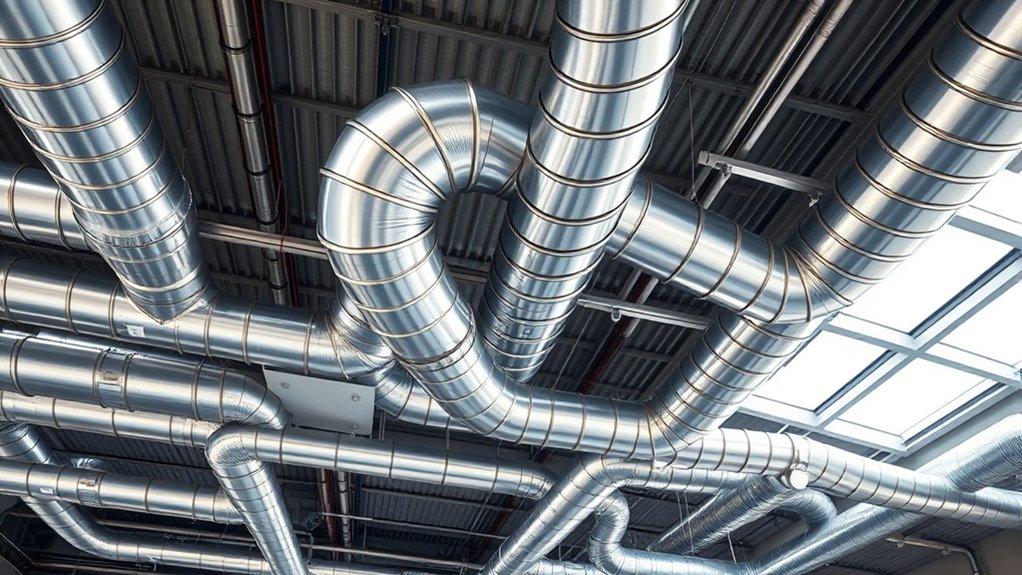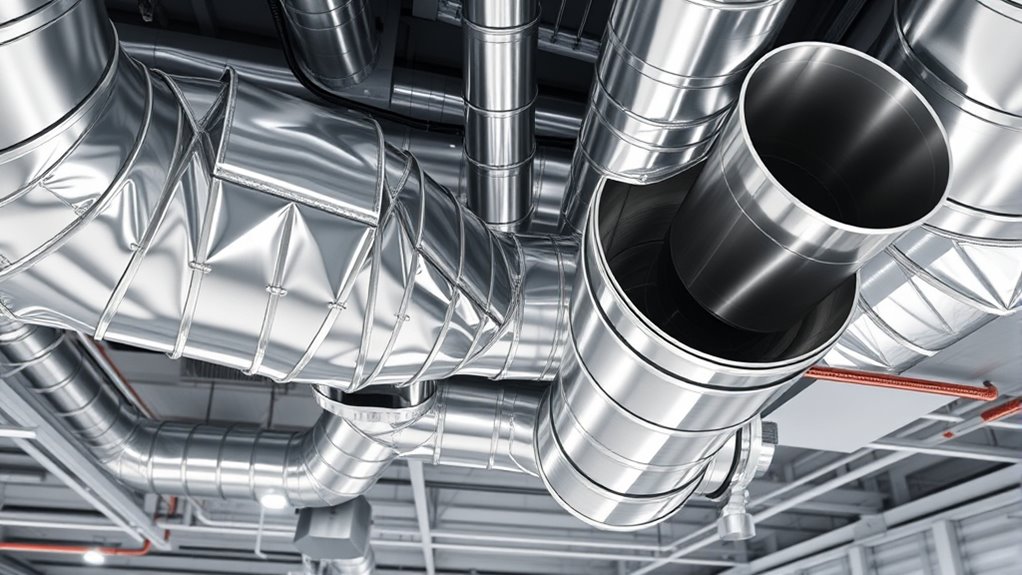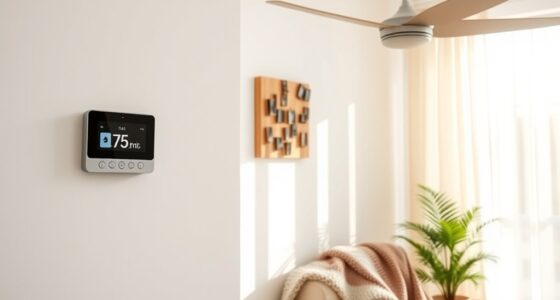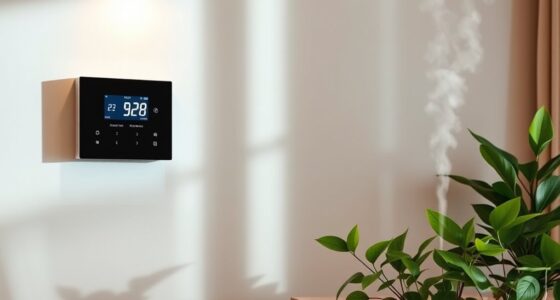To design ductwork for ideal airflow, start by accurately calculating your heating and cooling loads to determine the right duct size. Keep duct runs straight and minimize bends to reduce pressure loss. Use proper sizing for branches and ensure vents are strategically placed for balanced distribution. Insulate ducts in unconditioned spaces and include dampers for airflow adjustments. Proper planning now guarantees energy efficiency and comfort—if you want detailed steps, keep exploring these tips further.
Key Takeaways
- Calculate heating and cooling loads accurately to determine proper duct sizes for balanced airflow.
- Use straight, direct duct runs with minimal bends to reduce pressure losses and improve airflow efficiency.
- Properly size supply and return vents for even distribution and to prevent hot or cold spots.
- Insulate ducts passing through unconditioned spaces to minimize energy loss and maintain airflow temperature.
- Regularly inspect and seal duct connections to prevent leaks, ensuring optimal airflow and system performance.

Creating an efficient ductwork system is essential for guaranteeing ideal airflow in your heating, ventilation, and air conditioning (HVAC) setup. Properly designed ductwork guarantees that heated or cooled air reaches every corner of your space evenly, providing comfort and energy efficiency. To achieve this, you need to pay close attention to duct sizing and airflow distribution from the start.
Designing efficient ductwork ensures optimal airflow, comfort, and energy savings in your HVAC system.
Duct sizing plays a pivotal role in maintaining optimal airflow. If your ducts are too small, the air pressure will increase, leading to noise, energy waste, and uneven temperature distribution. Conversely, oversized ducts can cause insufficient airflow, reducing system efficiency and causing discomfort. To get the sizing right, you should base your calculations on the actual heating or cooling load of your space, the desired airflow rate, and the static pressure your system can handle. Using tools like the ACCA Manual D or specialized software can help you determine the correct duct dimensions, ensuring that airflow remains steady and balanced throughout the system.
Airflow distribution is equally critical. Once you’ve appropriately sized your ducts, you need to ensure that the air moves smoothly and evenly to all outlets. This involves designing a layout that minimizes unnecessary bends, turns, and long runs, which can cause pressure drops and reduce airflow efficiency. Keep duct runs as straight and direct as possible, and use appropriately sized branches to prevent pressure imbalances. Distributing airflow evenly across multiple vents means balancing duct lengths and sizes so each room receives the right amount of conditioned air. Properly designed airflow distribution minimizes hot or cold spots and maximizes comfort.
It’s also important to consider the placement of supply and return vents. Strategically locating these vents ensures that air circulates effectively, avoiding stagnation or uneven temperature zones. Using dampers and adjustable registers allows you to fine-tune airflow to specific areas, compensating for any minor imbalances in duct design. Insulating ducts, especially those running through unconditioned spaces, helps prevent energy loss and maintains airflow quality. Additionally, incorporating noise reduction technology during design can help minimize operational noise and enhance comfort.
Finally, regular inspection and maintenance are essential. Over time, dust buildup or duct damage can impair airflow, making your initial design less effective. Checking duct connections, sealing leaks, and replacing filters keep your system operating at peak efficiency. When you focus on proper duct sizing and airflow distribution from the outset, you create a resilient, efficient HVAC system that delivers consistent comfort and saves energy in the long run.
Frequently Asked Questions
What Are the Common Mistakes to Avoid in Ductwork Design?
You should avoid common mistakes like improper duct sizing, which can cause airflow issues or energy loss. Make certain you select the right insulation methods to prevent heat transfer and maintain efficiency. Don’t overlook the importance of smooth progressions and avoiding sharp bends, as these disrupt airflow. Also, neglecting proper sealing can lead to leaks, reducing system performance. Focus on accurate calculations and quality materials to design effective, efficient ductwork.
How Does Duct Material Affect Airflow Efficiency?
Duct material substantially impacts airflow efficiency because smoother materials like aluminum or galvanized steel reduce friction, allowing air to flow freely. Avoid rough or flexible materials that cause turbulence and resistance, decreasing efficiency. You should choose durable, smooth-lined ducts to maintain ideal airflow. Proper sealing and insulation of the duct material also prevent leaks and temperature loss, ensuring your system runs efficiently and saves energy.
What Tools Are Best for Measuring Airflow in Ducts?
You should use an anemometer to measure airflow in ducts, ensuring it’s properly calibrated for accurate readings. For detailed analysis, incorporate airflow visualization tools like smoke sticks or fog generators to see airflow patterns clearly. These tools help identify turbulence or blockages, improving duct design. Regular anemometer calibration guarantees precision, making your airflow measurements reliable and effective for optimizing ductwork performance.
How Often Should Ductwork Be Inspected or Maintained?
You should inspect and maintain your ductwork at least once every 3 to 5 years, though some might say that’s overkill—until dust buildup causes allergies or inefficiency. Regular duct cleaning and an inspection schedule help prevent blockages and improve airflow. Don’t wait for noticeable problems; proactive maintenance keeps your system running smoothly, saving money and breathability in the long run.
Can Duct Design Impact Indoor Air Quality Significantly?
Your duct design can profoundly impact indoor air quality by influencing airflow patterns and the effectiveness of duct insulation. Properly designed ducts ensure even air distribution, reducing stagnant zones where pollutants can accumulate. Good duct insulation minimizes temperature fluctuations and prevents mold growth. When you optimize these aspects, you create a healthier indoor environment, improve air circulation, and reduce the risk of airborne contaminants, making your space more comfortable and safer.
Conclusion
So, now that you’ve mastered the art of designing ductwork, go ahead and enjoy the sweet symphony of perfectly balanced airflow. Who knew that a few bends, proper sizing, and strategic placement could turn your home into a breeze? Just remember, if your rooms still feel stuffy, it’s probably not the ductwork’s fault—blame the universe for conspiring against your airflow dreams. Happy ducting, and may your air always flow as smoothly as your newfound knowledge!









